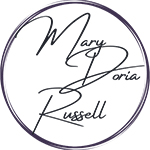Everybody’s routine goes to hell during the holidays, which is why January is such a relief for people like me. I like a nice comfortable rut. Few things make me happier than looking at the calendar and seeing an entire week of sweet nothing stretching out before me. I like to think of these brief episodes as “normal life,” when in fact they occur about three times a year and rarely last more than two days before something comes up.
Nonetheless, for the first six weeks of 2012, my days were pretty much my own, even though the bathroom next to my office was being gutted and remodeled. The tradesmen arrived promptly at 8 AM, and they got used to the fact that Mrs. Russell works in her pajamas and robe. We all went about our business with efficiency and dispatch. By the middle of February, the bathroom was finished, and The Cure for Anger had been rocketing along at a rate of 600-1000 words a day.
In the past two weeks, life has lost its rhythm. Our golden retriever Leo came to the end of his life. The very next morning my husband Don had to leave for two weeks in China on business. Then Annie the dachshund had her little veterinary adventure. And I’ve stopped pushing forward with the story.
At 46,000 words, The Cure For Anger is approximately one-third written. I’ve really been pressing hard to get this novel done by the end of the year. First off, that’s when Harper Collins expects it, but there’s another deadline — more theoretical, but no less motivating. If HBO does decide to green-light a series based on Doc, and if it’s successful enough to warrant a second season, then I want The Cure For Anger to shape the HBO version of the gunfight at the O.K. Corral. So I’ve got to get this novel complete, if not finished, in time for the screenwriters to be influenced when they deal with the Tombstone part of Doc’s story.
That said, I needed to stop and print out the manuscript to see how it’s working so far.
Now, I’m a religious recycler who won’t even throw away those annoying subscription inserts in the magazines that I feel guilty about because I don’t read them on a tablet. (I read magazines to get away from the damned computer screen.) So I really try to minimize the amount of printing I do. Years ago, however, I noticed that a passage could seem good on-screen, but when I printed it out and reread on paper, I’d find dozens of things wrong with it — spelling, grammar, pacing, logic, repeated words, on and on.
When I get further into the story, and print out, I find not just paragraphs out of place and sentences in the wrong order, but whole chapters that don’t belong where I put them initially. Traditionally, at this stage in the process, I start to wonder, “Was I drunk when I wrote that? Or are these the first tragic hints of an irreversible cognitive decline?”
So I don’t trust my opinion of my work until I’ve changed from screen to paper, and I was prepared to find the first third of The Cure For Anger embarrassingly bad. Which it was.
Partly it was bad because six months ago, I decided to put the story in present tense. I wanted to make the reader feel the pressure and speed of the events that led up to the gunfight in Tombstone. I did A Thread of Grace in present tense for the same reason: the reader knows where those trains full of Jews are going, but the characters don’t and they have to make their decisions on the fly, without full knowledge of the risks they’re taking. But putting this novel in present tense robbed me of the narrative voice I developed in Doc, and that was narrowing the scope of the story, making character development less nuanced. And the manuscript felt unbalanced to me: some chapters far too short, others too long. I’ve under-weighted some characters, and need to fill them out more. That kind of thing.
So it’s time for mid-course corrections. I’ve spent 10 days changing the verb tense. When that’s done, I’ll reprint again and lay out each chapter in a separate pile, to see and feel the actual physical weight of them, and address the balance issues by scissoring chapters apart and reassigning passages, finding unexpected themes in the writing, as I work. I’ll cut and paste on-screen again, and reprint, and it will take maybe two more iterations before the changes have all been worked out. Then I can go forward again.
The first 30% of a story is its foundation. The foundation of a novel has to be solid, or you risk having the whole structure crumble later on.
